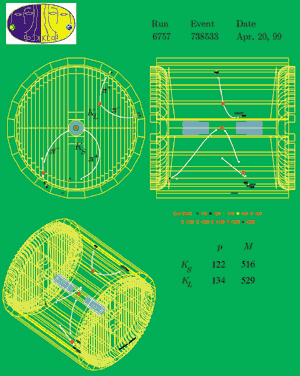
The DAFNE electronpositron collider at Frascati and its KLOE detector are flexing their muscles. On 14 April, during the first DAFNE tune-up using two beams and with the KLOE superconducting detector solenoid in operation, a luminosity of 1.2 x 1029 per sq. cm/s was reached in single bunch mode with 11 mA in the positron beam and 7 mA for electrons, corresponding to some 70% of the expected luminosity for this current.
The first electronpositron scattering events were seen in the KLOE detector. A preliminary estimate of the event rate is in agreement with indications from the machine luminosity monitor.
DAFNE operates at the phi meson resonance (1020 MeV). The ensuing scan of the phi peak produced the first CP-violating decays of long-lived kaons. Such decays will provide more information on the mystery of CP violation, through which nature is able to discriminate between matter and antimatter.
The phi is only slightly heavier than a pair of neutral kaons (498 MeV each), and kinematically this decay is very constrained. At first sight, phi decay via a rho meson (770 MeV) and a pion (140 MeV) should be easier. However, the phi prefers to decay into two kaons, which produces strange results.
The phi meson was first seen in bubble chamber experiments at Brookhaven in 1962. Its decay behaviour motivated George Zweig, who was then at Caltech, to propose his model of “aces”, which paralleled the invention of quarks by Murray Gell-Mann (see the story next month, and more news of DAFNE commissioning).





